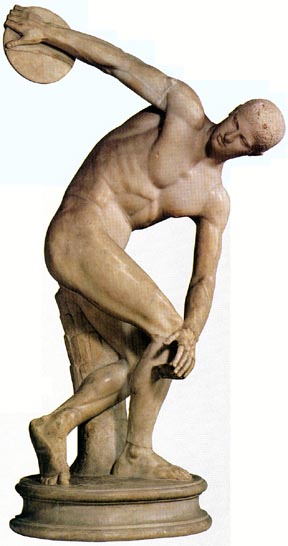|
Sometime, probably just before the Persian sack of Athens in 480 BCE, sculptors took the momentous step that finally produced a pose in standing figures more in harmony with the increasing realism of the anatomical renderings seen in Archaic Kouros and Kore statues.

The Kritios Boy
Kouros attributed to the sculptor Kritios
c. 480 BCE
Marble. Height 3' 10"
(The Acropolis Museum, Athens)
In the "Kritian" or "Kritios" Boy (named after his likeness to another statue by a sculptor named Kritios), weight has been transferred to the left leg (shown by the elevation of the left buttock). The head, also, is slightly turned toward the flexed leg, thus setting up the beginning of a rhythm within the figure. The structure of body and of head now shows a more developed mastery of anatomy (although a certain simplification is to be seen, which characterizes the Early Classical or Severe Style). The physical changes in the Kritios Boy are actually rather small, but the consequences are enormous. The statue comes to life. The technical challenge posed was considerable, with probably some experiments first in bronze (note the formerly inset eyes, such as one would find in a bronze statue)

Myron
Discobolos
Roman copy after a Greek bronze original of about 450 BCE
Marble. Height 5' 1"
(Rome, Museo Nazionale delle Terme)
The sculptor Myron worked in middle years of the 5th century. His work combines the Severe Style and some High Classical characteristics. The innovative pose and composition of the Discobolos is not seen again until Hellenistic times. Myron avoids Archaic symmetry and instead introduces a marked contrast between the sweeping curve of right side and the jagged zigzag of the left side.
Only Roman copies are known. The original bronze would not have needed the supporting tree trunk. It shares with the Artemision Zeus an openness of form and a static anatomy (the tension of the various parts of the body are barely shown). Also, like the Artemision Zeus, the statue is meant to be viewed from only one single angle. It is unnaturally flattened, with the torso seen from front while the legs are in profile. The features have been simplified with an idealized musculature and features. The figure lacks both individuality and emotion. The head seems divorced from action of the body.

Charioteer of Delphi
from Delphi
Bronze, with copper lips and eyelashes, a silver headband, and onyx eyes
c. 478 or 474 BCE
Marble. Height 5' 11"
(Archaeological Museum, Delphi)
This life-size bronze statue originally stood in a chariot with horses. It was placed in the Sanctuary of Apollo, Delphi, to commemorate a chariot race. The figure represents the driver of the chariot. The owner of the chariot and horses, whose victory is actually being celebrated, is not shown (though it is thought that he may have been standing in the chariot next to this figure). The figure wears a belt above waist, with straps over shoulders and behind neck to hold down drapery in the wind when the chariot is being driven at speed. The figure stands with Classical poise.

Artemision Zeus
from the sea near Cape Artemision
c. 460-450 BCE
Bronze. Height 6' 101/2"
(National Archaeological Museum, Athens)
This larger than life-size statue shows the characteristics of new style. The figure is shown about to throw a weapon (trident, if Poseidon; thunderbolt, if Zeus), which is grasped in the right hand with the right arm pulled back. The left arm extended forward, towards target. The figure stands firmly, with the weight resting on left foot. The right foot only lightly touches the ground. This extended pose expresses momentary action. However, there is no differentiation between expanded and contracted muscles. Moreover, the figure is not really three-dimensional as it may look; in fact it is rather flat.
The head, with its elaborate treatment of hair and beard, captures the majesty and power of the traditional gods, creating an image of a superior being in a human form. The loss of the eyes (once inlaid) now gives even an greater power to the face.
|

 SPRING 2016
SPRING 2016  SCHEDULE
SCHEDULE  REQUIREMENTS
REQUIREMENTS

 SPRING 2016
SPRING 2016  SCHEDULE
SCHEDULE  REQUIREMENTS
REQUIREMENTS